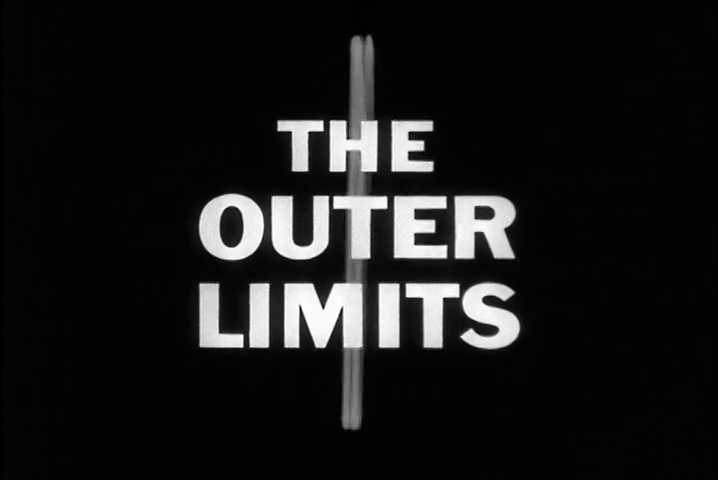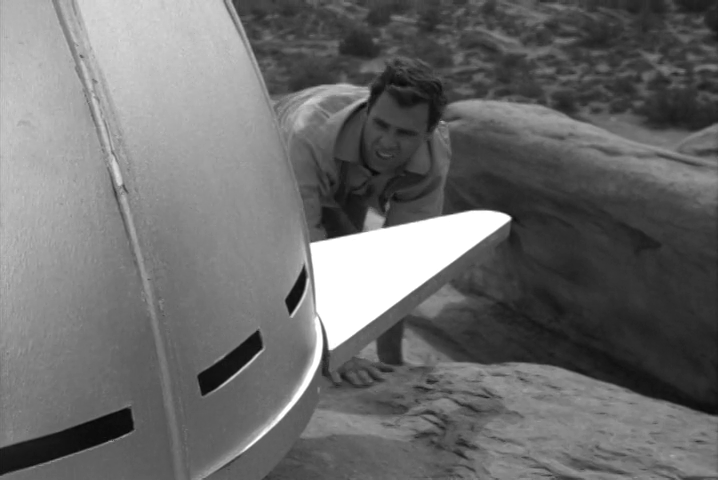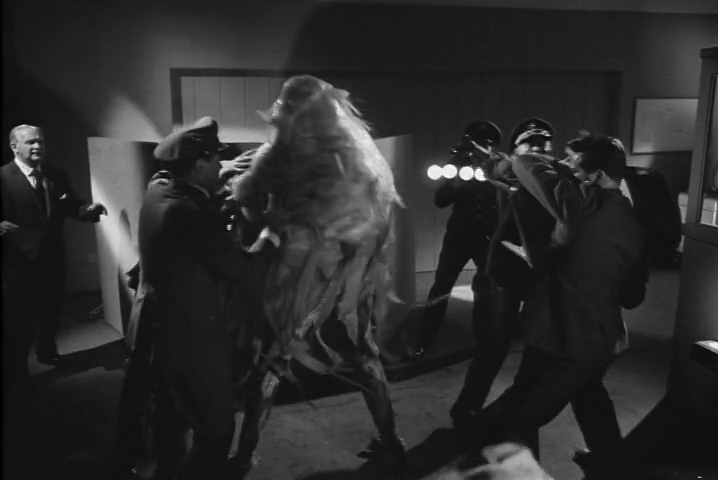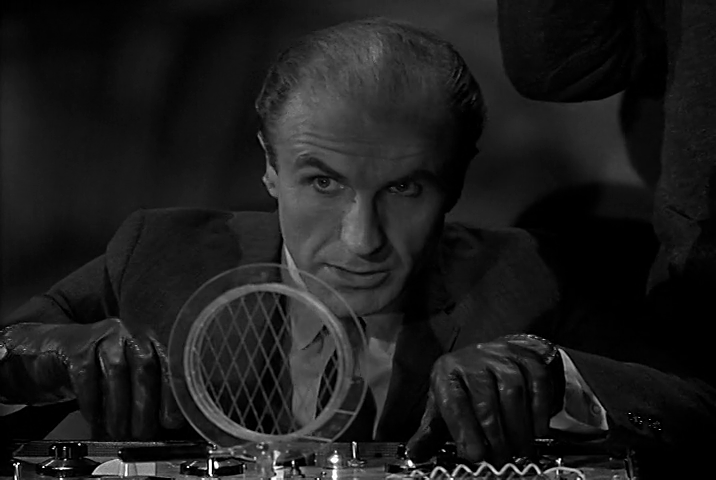
by Natalie Devitt
This past month on The Outer Limits has been a meditation on man’s past actions and his darker qualities. Over the course of the month, I watched men motivated by greed, aliens target Earth specifically because of their negative perception of people, scientists treat their fellow men like nothing more than laboratory animals, and Martians try to figure out what motivates human beings to kill one another.

Tourist Attraction, by Dean Riesner
While aboard his yacht in South America, millionaire and United States citizen John Dexter, portrayed by Kiss Me Deadly’s Ralph Meeker, captures a fish that is larger than your average fish. In addition to its massive size, one of the men aboard his yacht observes that it “has hands and feet.” Dexter soon finds out that the animal’s extremities are not the only thing special about the creature and that the locals have legends about it.

The fish is frozen and taken to a local university for research, where it thaws out and almost escapes. Hungry for fame, Dexter makes arrangements to bring the being with him when he returns to the states. The only thing that stands in his way is General Juan Mercurio, the dictator of the country. Mercurio is played by Ocean 11’s Henry Silva, and he plans to make the fish part of an exhibit at the World’s Fair, in hopes of boosting the country’s dwindling tourism industry.
One thing that sets Tourist Attraction apart from previous entries in the series is its frequent use of narration. The average episode of The Outer Limits only uses a narrator for the opening and closing monologue, but Tourist Attraction uses it off and on throughout the story, which is frustrating because it does not seem to add much. If anything, the narrator can be a bit distracting, especially since he disappears for a while, just to start again suddenly.
One other downside to the episode is that it is hard to watch Tourist Attraction and not think that it may be a little too heavily influenced by Creature from the Black Lagoon and the two sequels that followed. Even with all the things counting against this episode, for some reason I found myself entertained. It is not nearly as sophisticated or as artistically ambitious as something like last month's Nightmare, but it is enjoyable, and would probably not be out of place as the B movie in a double feature. Tourist Attraction earns three stars from me.
The Zanti Misfits, by Joseph Stefano

The Zanti Misfits takes place in a ghost town in California. Professor Steven Graves, a “historian of interplanetary events”, performed by television actor Michael Tolan, goes to observe a penal ship from the planet of Zanti land in what is supposed to be a “non-hostile sequence.”
The Zanti have an agreement with the United States government, where the government allows the aliens to land their spacecraft in the deserted town and use it as “a place of exile for their criminals and misfits.” If the government does not properly secure the area and maintain their privacy, the extraterrestrials vow “total destruction.”
As luck would have it, the aliens are in the process of landing their spaceship when the Zanti spot a couple, played by Bruce Dern and Olive Deering. The couple are fleeing the scene of a crime and have driven into the restricted area. Thinking their privacy was been invaded, the Zanti are determined to make sure there were no witnesses to their landing, and later reveal a surprising reason for picking Earth for their colony, which is that they view humans as “practiced executioners.”
This episode's creatures are certainly memorable, with their ant-like bodies and faces that look all too human. As interesting as the Zantis look, the episode’s greatest strength aside from the story, is probably its use of stop-motion animation, which is best captured in a sequence where the Zanti chase after Olive Deering’s character, Lisa. The entire thing is shot in broad daylight, but the stop motion combined with buzzing sounds of the Zanti make it enough to give anyone nightmares. All in all, this episode is the standout of the month, which is why it earns four stars.
The Mice, by Bill S. Ballinger and Joseph Stefano

Henry Silva returns for a second trip to The Outer Limits this month. In The Mice, he plays a convict named Chino Rivera, who volunteers to be a test subject in an experiment. In the experiment, Rivera will teleported to the planet of Chromo. In exchange, Chromo will send one of their beings. When Chromo transmits one of their inhabitants, the scientists encounter a being infinitely more dangerous than Rivera.
Tourist Attraction did not do much to showcase Silva’s talent as an actor, but The Mice certainly does. Silva makes a convicted murder the most likable character in the whole story, even when the other characters do not treat him with the respect he deserves and he has to remind them that he is person, just like them.
What would The Outer Limits be without the crazy monsters and aliens? The Mice certainly delivers one of the strangest monsters I have seen yet, one that resembles a glob of mucus. Also, like most episodes of the series, it does not hurt that the episode is beautifully filmed. The Mice receives three and a half stars from me.
Controlled Experiment, by Leslie Stevens

Carrol O'Connor and Barry Morse star as two Martians in Controlled Experiment. Barry Morse, who most Twilight Zone fans will recognize from A Piano in the House plays Phobos One, an alien who enlists the help of television actor Carrol O'Connor's character, Deimos, to understand the "process of Earth creatures destroying each other." Shortly before a murder in committed, their fellow Martians inform them of the time and location. Once they receive the information, Phobos One and Deimos bring a machine that helps them manipulate time and rush to a local hotel lobby, where they wait for the murder to take place.
As the Martians play with their devise and change time, a number of special effects are utilized. There are times that the images on screen resemble film negatives. Other times, images come into and out of focus. The men from Mars freeze time and replay events that have already occurred. When events are replayed, sometimes they are in slow motion, while other times things are sped up. Controlled Experiment is similar to the previous episode Borderlands, because it does not have the strongest story but it often looks fantastic.
The whole thing felt a bit long to stretch out for a full hour, especially since the Martians replay the same event over and over. It works for a while, but then starts to wear thin. One thing worth noting is that this episode marks the show’s first foray into comedy, even if it is making light of a serious issue. Due to its visual achievements, it is better than The Twilight Zone's attempts at humor, but it is far from the most memorable entry of The Outer Limits. I can only give Controlled Experiment two and a half stars, which are primarily for its special effects and cinematography.

As dark as The Outer Limits has been recently, it has been mostly rewarding to watch and it has expressed hope for a brighter future. To wit: the closing monologue to The Mice, which states, “Wouldn’t it seem that the misery known and understood by all men would lead Man not to deception and murder, but to faith, and hope and love?”
(Did you read about all the ways the Journey expanded last year? Catch up and see what you missed!)

![[January 16, 1964] Man’s Dark and Troubled History (<i>The Outer Limits</i>, Season 1, Episodes 13-16)](https://galacticjourney.org/wp-content/uploads/2019/01/640116e-672x372.png)
